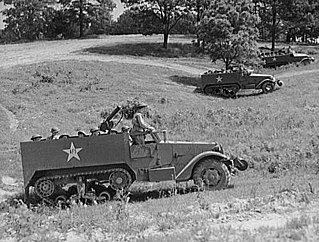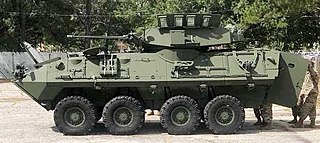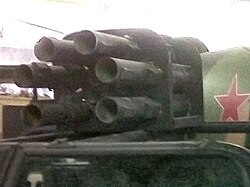
The Bradley Fighting Vehicle (BFV) is a tracked armored fighting vehicle of the United States developed by FMC Corporation and now manufactured by BAE Systems Land & Armaments, formerly United Defense. It is named for U.S. General Omar Bradley.

The M113 is a fully tracked armored personnel carrier (APC) that was developed and produced by the FMC Corporation. The M113 was sent to United States Army Europe in 1961 to replace the mechanized infantry's M59 APCs. The M113 was first used in combat in April 1962 after the United States provided the South Vietnamese army (ARVN) with heavy weaponry such as the M113, under the Military Assistance Command, Vietnam (MACV) program. Eventually, the M113 was the most widely used armored vehicle of the U.S. Army in the Vietnam War and was used to break through heavy thickets in the midst of the jungle to attack and overrun enemy positions. It was largely known as an "APC" or an "ACAV" by the allied forces.

The Wiesel Armoured Weapons Carrier is a German light air-transportable armoured fighting vehicle, more specifically a lightly armoured weapons carrier, produced by Rheinmetall.

The Véhicule de l'Avant Blindé or VAB is a French armoured personnel carrier and support vehicle designed and manufactured by Renault Trucks Defense. It entered French service in 1979 and around 5,000 were produced for the French Army as well as for export. It has seen combat in various conflicts in Africa, Asia as well as Europe and has also been exported to more than 15 countries.

The M3 half-track was an American armored personnel carrier half-track widely used by the Allies during World War II and in the Cold War. Derived from the M2 half-track car, the M3 was extensively produced, with about 15,000 standard M3s and more than 38,000 variant units manufactured.

The M8 light armored car is a 6×6 armored car produced by the Ford Motor Company during World War II. It was used from 1943 by United States and British forces in Europe and the Pacific until the end of the war. The vehicle was widely exported and as of 2006 still remained in service with some countries.

The LAV-25 is a member of the LAV II family. It is an eight-wheeled amphibious armored reconnaissance vehicle built by General Dynamics Land Systems and used by the United States Marine Corps and the United States Army.

The BRDM-1 is a Soviet amphibious armored scout car. It was the first purpose-built Soviet reconnaissance vehicle to enter service since the BA-64 and was built on the chassis and drive train of the BTR-40 armored personnel carrier. It is the world's first mass-produced combat vehicle of its class.

The Lamborghini Cheetah was an off-road prototype built in 1977 by the Italian carmaker Lamborghini.

The M113½ Command and Reconnaissance Vehicle is a United States-built tracked reconnaissance armoured fighting vehicle, which was originally employed by the armed forces of the Netherlands and Canada and later Bahrain and Chile. Former Dutch vehicles were exported in the 1990s to Bahrain and Chile after being retired from service.

The AIFV is a US tracked light armored vehicle that serves as an infantry fighting vehicle (IFV) in the armies of several countries. It is a development of the M113A1 armored personnel carrier.
A huge number of M113 Armored Personnel Carrier variants have been created, ranging from infantry carriers to nuclear missile carriers. The M113 armored personnel carrier has become one of the most prolific armored vehicles of the second half of the 20th century, and continues to serve with armies around the world in many roles.

The Simba is a wheeled armoured personnel carrier designed by GKN Sankey. It is currently in service with the Philippine Army.

The Komatsu light armored vehicle (Japanese: 軽装甲機動車; is a Japanese military vehicle first produced in 2002. Currently used exclusively by the Japan Self-Defense Force, it has seen use in the Iraq War. It is built by Komatsu Limited. Defense Systems Division in Komatsu, Ishikawa, Japan. Komatsu's factory designation for the vehicle is KU50W.

The EE-3 Jararaca is a Brazilian scout car developed for route reconnaissance, liaison, and internal security purposes. It was engineered by Engesa in response to a perceived Brazilian Army requirement for a light armored car capable of replacing its unarmored utility vehicles in the liaison and security role. The first Jararaca prototype appeared in 1979 and serial production commenced in 1982 after extensive operational testing in Brazil. It was ultimately rejected for large scale service with the Brazilian Army due to concerns over the limited mobility of its four-wheeled chassis but achieved some minor successes on the export market.
The Marine Multi-purpose Vehicle or MMPV is a 4x4 utility vehicle built by the Philippine Marine Corps. Similar in concept and appearance to the HMMWV, it was created to replace the M151 jeeps in service, which were becoming difficult to maintain due to a lack of available spare parts.
Akrep ("Scorpion") is a Turkish infantry mobility vehicle developed by Otokar Otobus Karoseri Sanayi AS. The first prototypes were completed in May 1993 and the first vehicles came off the production line in June 1994. In addition to light reconnaissance, the vehicles were used for escort, perimeter control, counterinsurgency, and light attack. The Akrep represented the latest offering in Otokar's portfolio of light vehicles for both civilian and military markets.

The Expeditionary Tank was a light tank developed in the 1980s initially by Teledyne Vehicle Systems. Later joined by General Dynamics Land Systems (GDLS), the companies entered the US Army's Armored Gun System (AGS) competition with the design. Since the tank never entered service, it did not receive an official designation. Alternative names for the Expeditionary Tank include the Teledyne Light Tank and the Slammer.

















